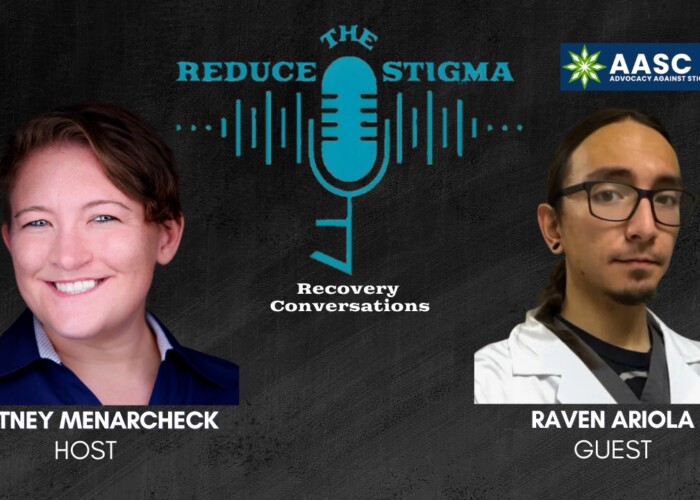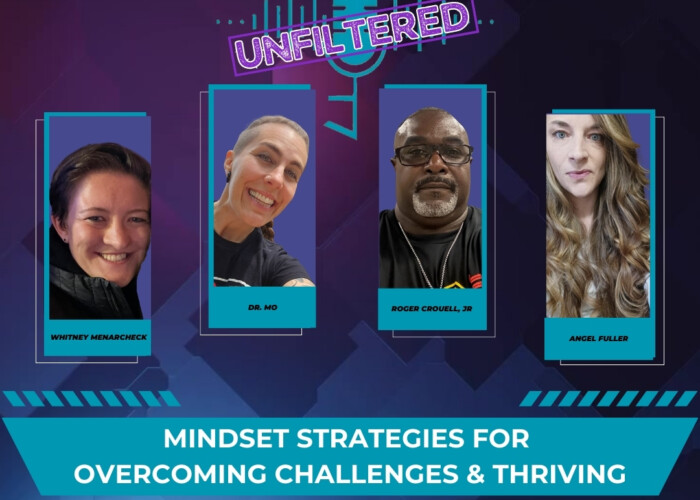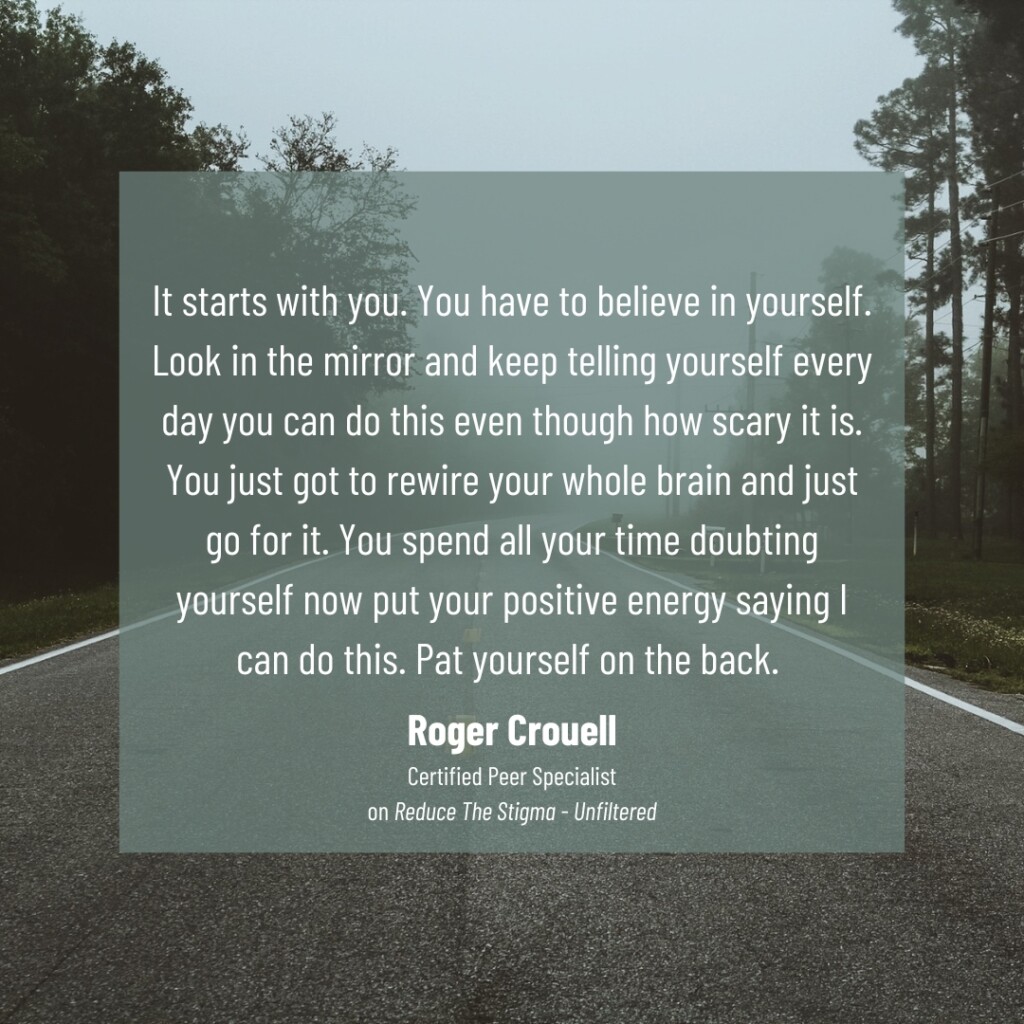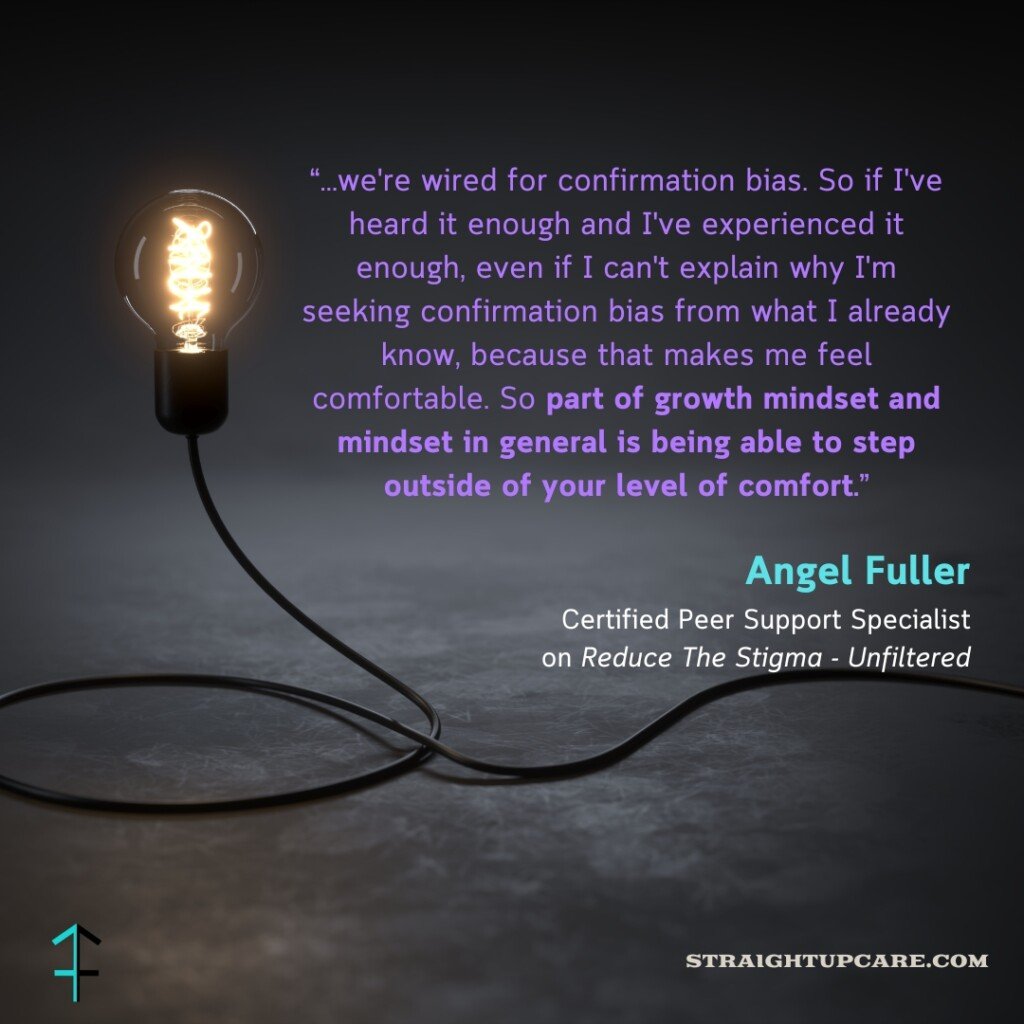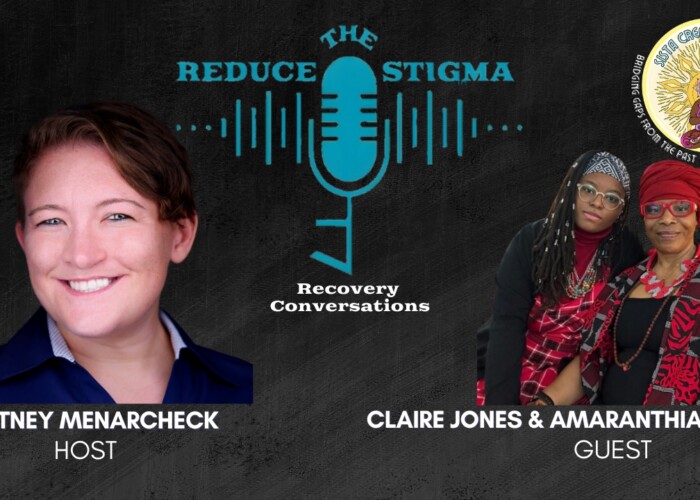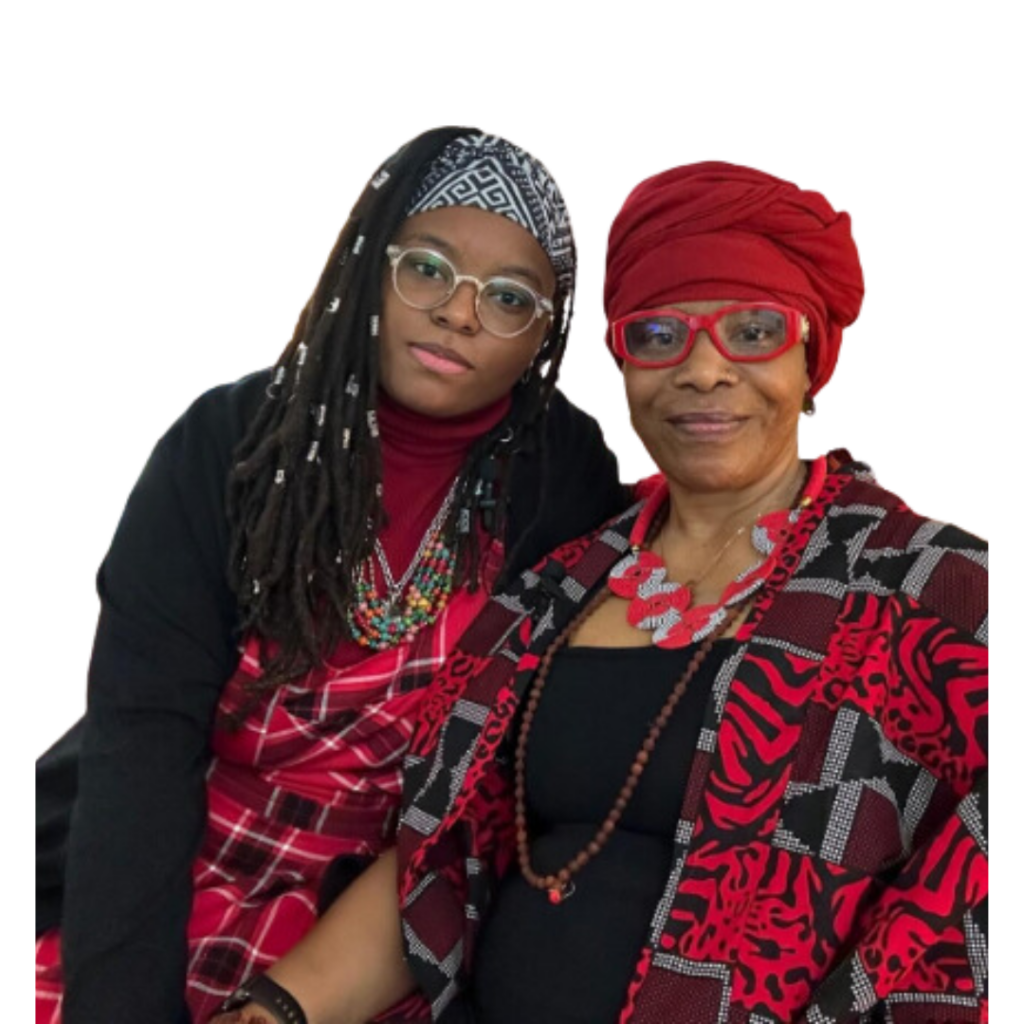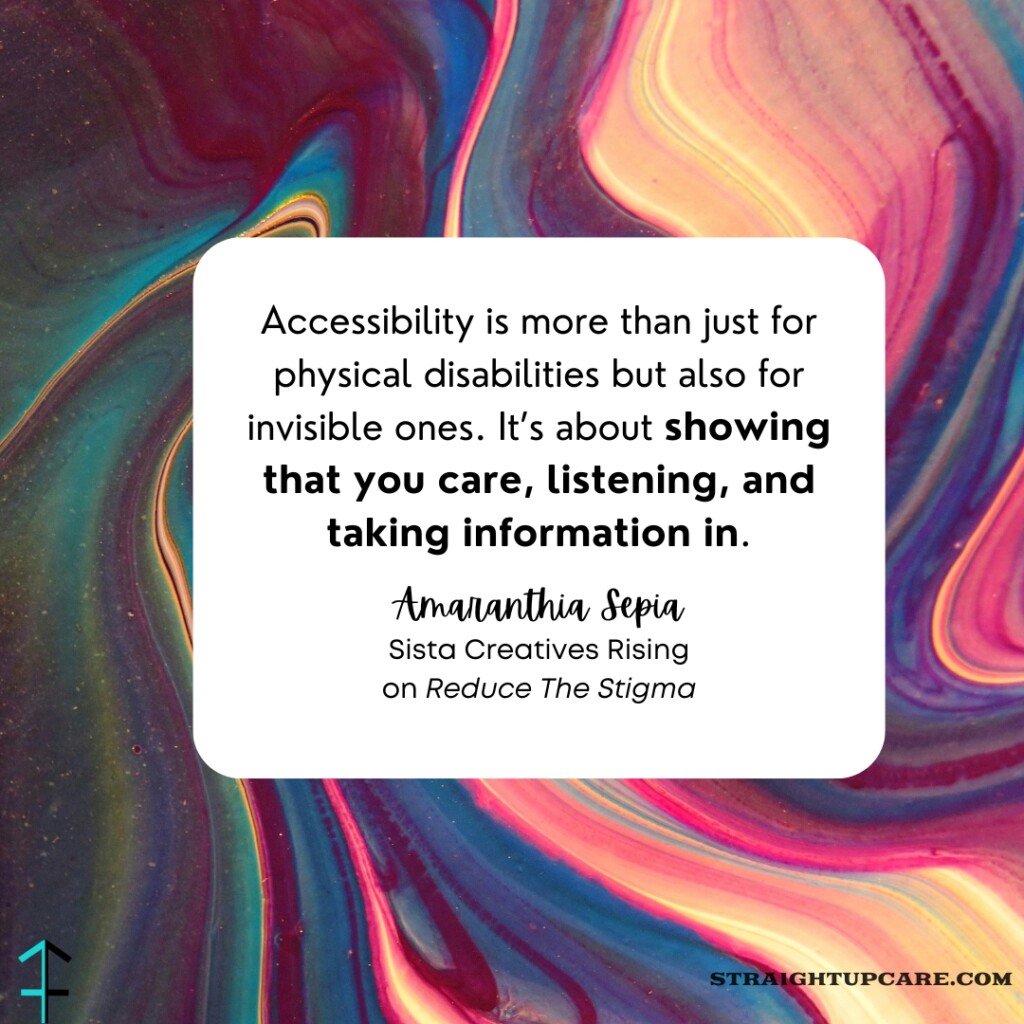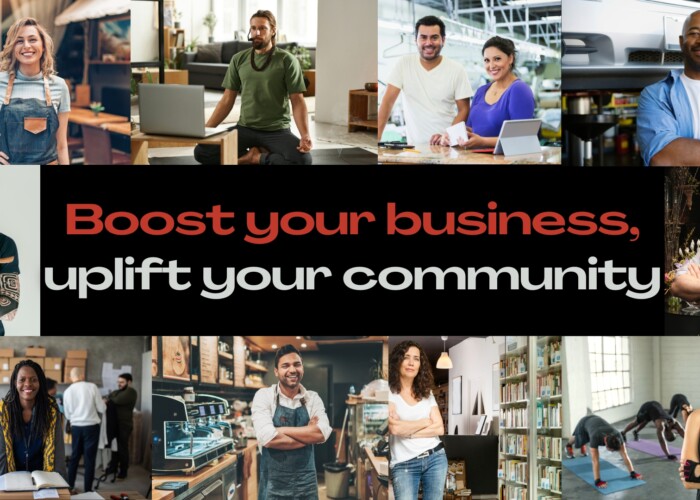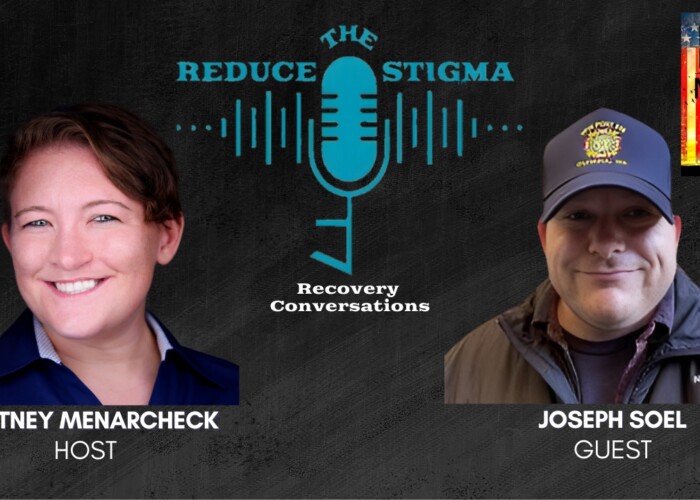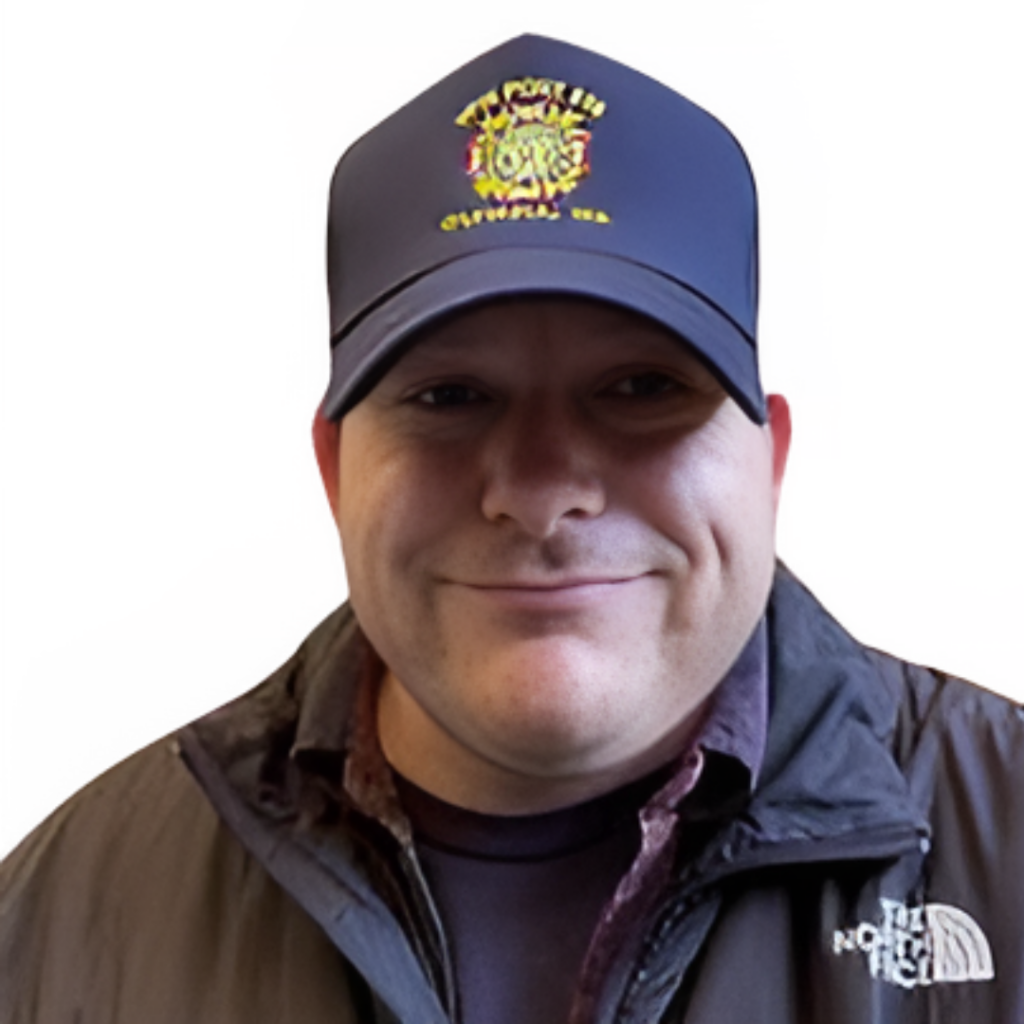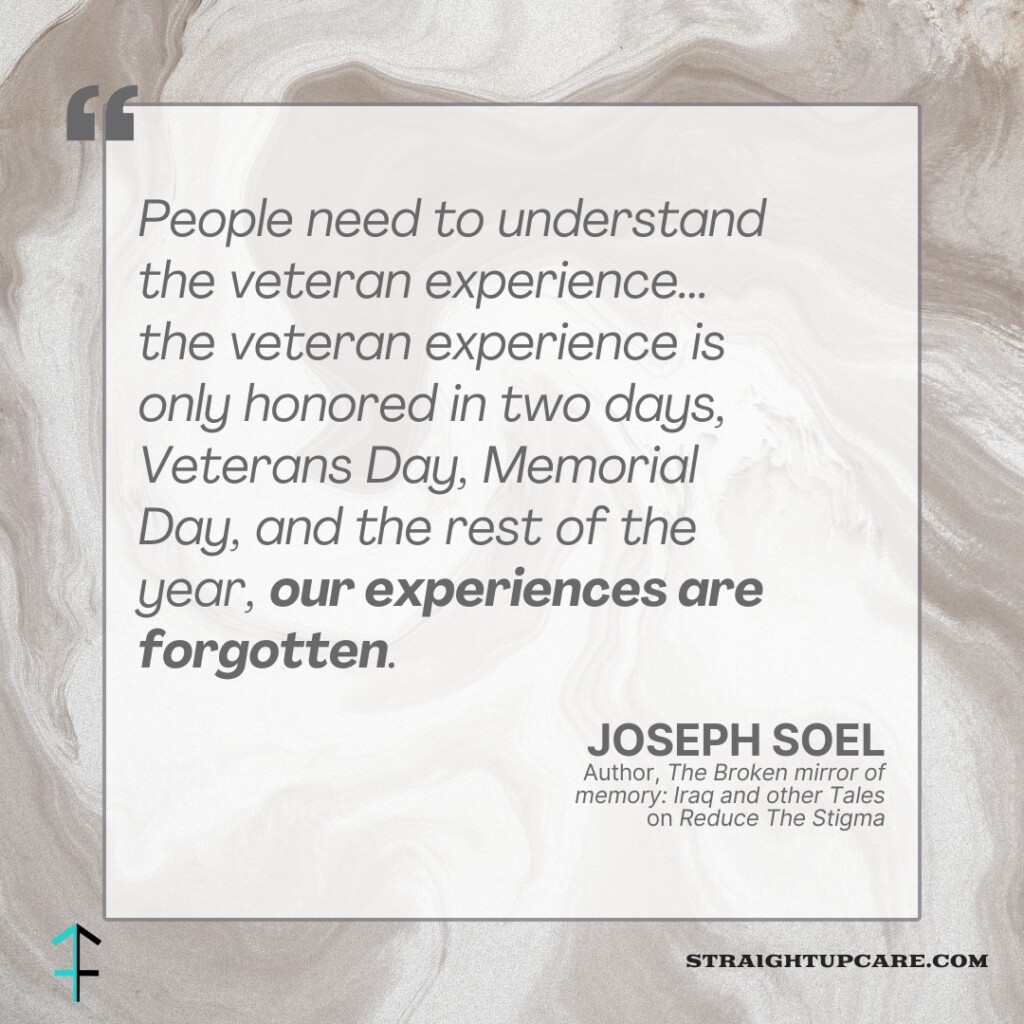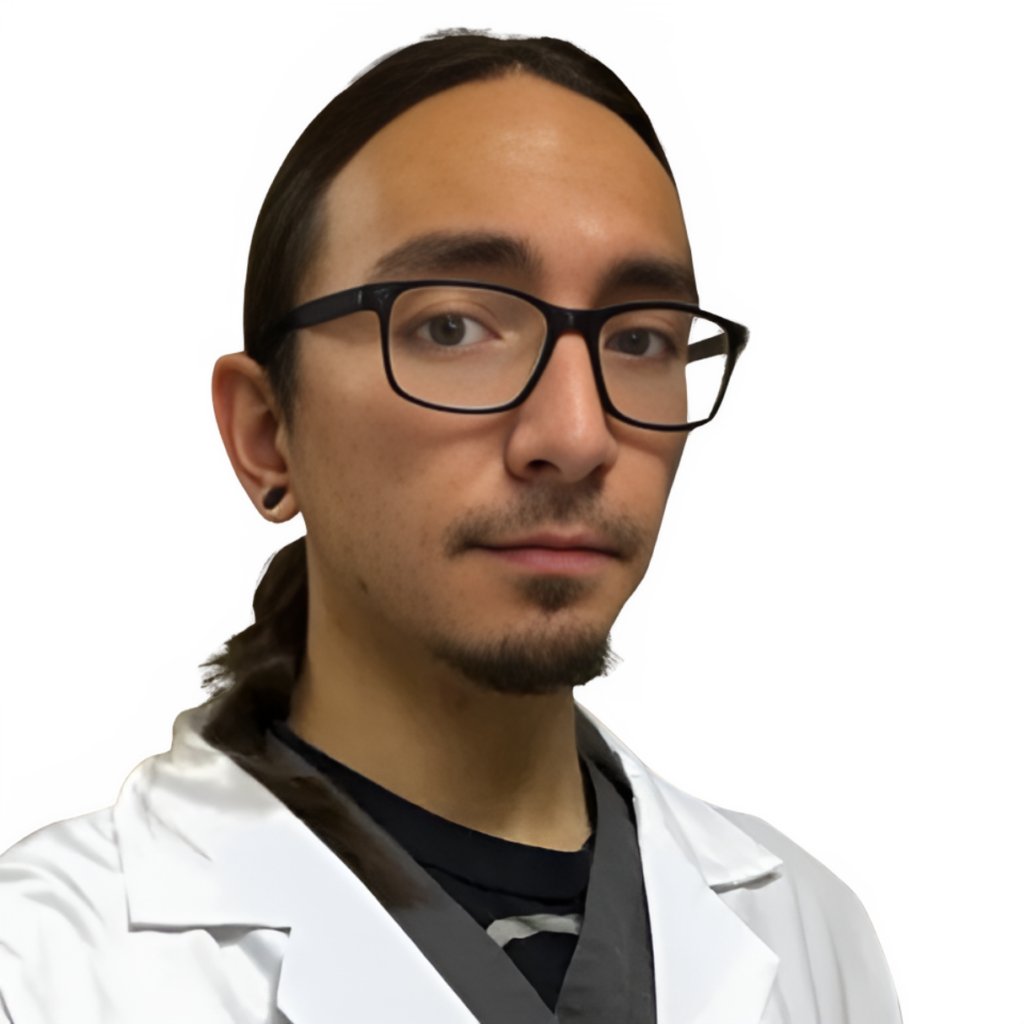
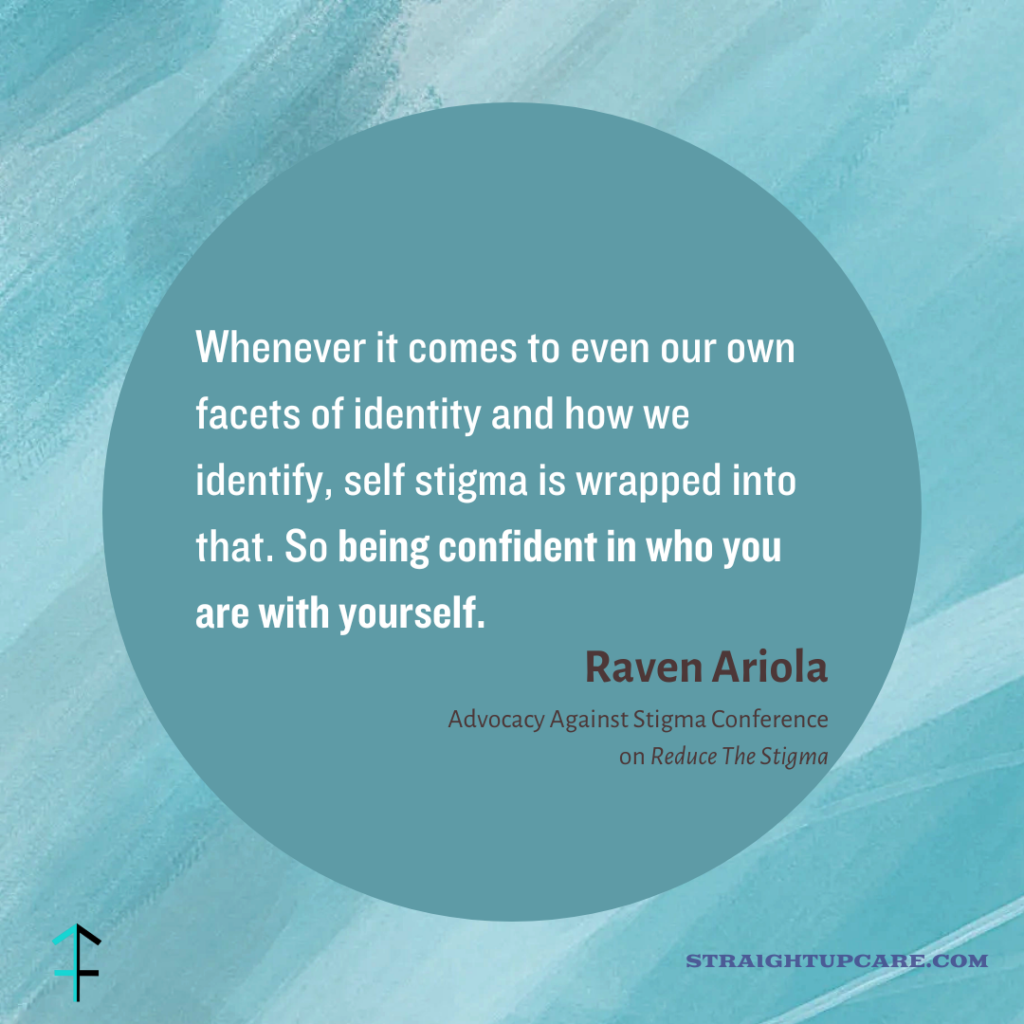
The Advocacy Against Stigma Conference tackles critical issues surrounding stigmatized life experiences and the barriers to healing created by pervasive stigma. This unique conference brings together individuals with lived experience, medical professionals, and advocates for a powerful exchange of stories and perspectives.
Explores the conference’s impact through a conversation with Raven Areola, co-creator of the event. We’ll delve into the importance of dismantling stereotypes, the role of lived experience in informing better treatment approaches, and the power of storytelling in fostering compassion and building a more inclusive community.
Click here for the episode’s full transcript.
Make sure you never miss an episode of Reduce The Stigma by subscribing on your preferred platform
How to Watch
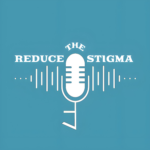
Watch on any device on ReduceTheStigma.com

Watch on Straight Up Care’s YouTube channel
How to Listen
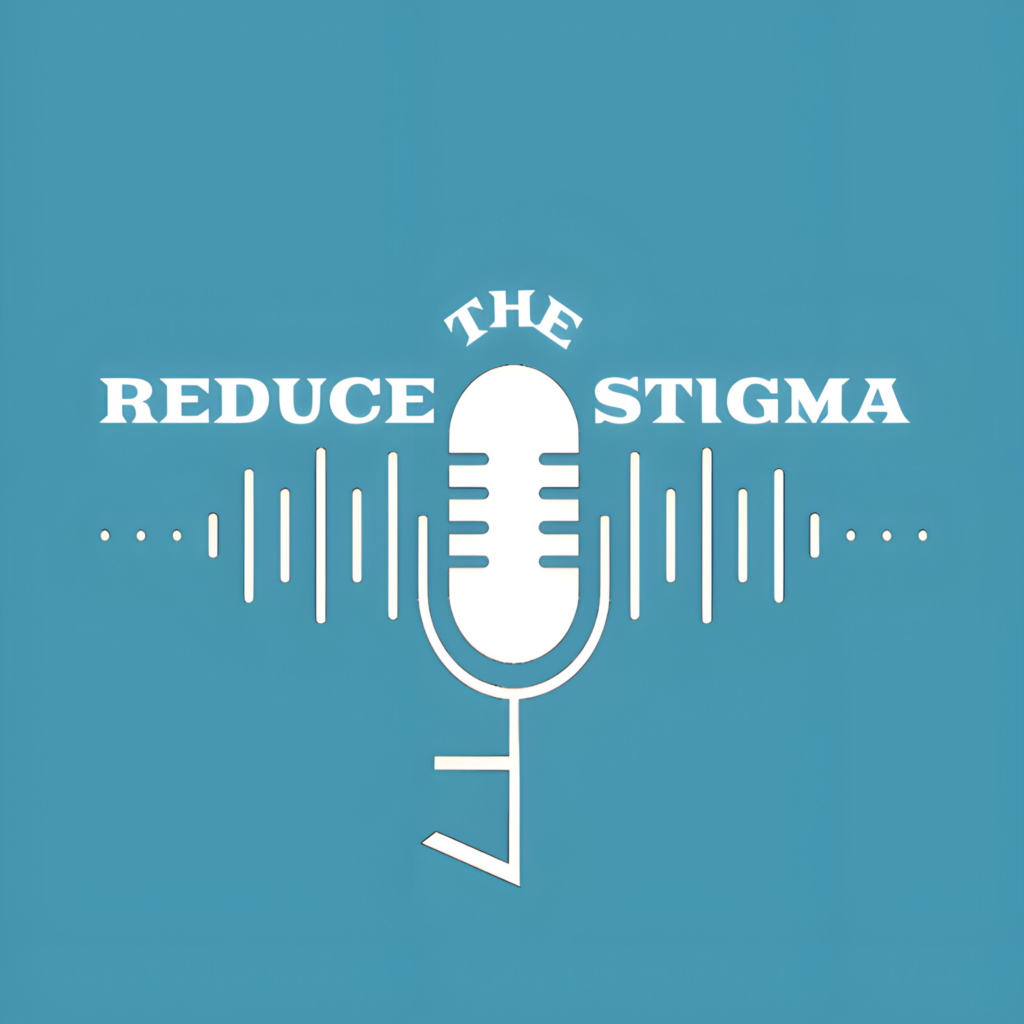
Our Podcast Website on Podops!
Listen on Apple Podcasts!

Listen on Spotify!

Listen on iHeart Radio!

Listen on YouTube Podcasts!
Follow Straight Up Care
Transcript
Whitney Menarcheck (00:01)
I attended the second annual Advocacy Against Stigma Conference in Pittsburgh, Pennsylvania. And I did something a little different. I met a few people and asked them to record a message, whatever they would like to say to help reduce stigma. And so I’m going to share those with you. And then we’re going to speak with Raven, one of the creators and leaders of the Advocacy Against Stigma Conference. And I’m really excited to also share that
Right after we finished our interview, I got word from Raven that the non -profit that he and his colleagues have been working on creating has been finalized. This is exciting news and we’re so happy for Raven, his colleagues, and what this means as we all continue fighting stigma.
Karley (01:58)
Okay, can you say your name? Sure, my name is Karley Snyder. Karley, what brings you to the conference today? So I’m here with the Students for Sensible Drug Policy Pittsburgh Community Chapter and we empower young people to do advocacy work both at their local community as well as the federal level.
So much of our work is around drug education, but there’s still unfortunately so much stigma tied around drug education, tied around mental health crisis, etc. So just one step at a time, having one conversation at a time to try to bridge that gap. That’s great. And you have been to a few conferences lately. You were just telling me off the mic.
Can you share something that kind of opened your mind that you learned about this week or had you thinking about things a little differently? Yeah, absolutely. So the conference I was at was NAMI’s Keystone Wellness Conference in Harrisburg.
And this was mainly a mental health conference, but the individual I met, she mentioned that she was in recovery. I automatically think drug and alcohol, just by that framing in general of those word choices. And just the nuance that she shared, no, that was from mental health issues. And she was in recovery from her traumatic experiences. And that just made my perspective shift slightly of, I may even have stigma of just the word recovery and how that directly correlates to drug and alcohol.
nothing maliciously intended on my end, but we’re also recovering from trauma. We’re recovering from mental health issues, rather. And it’s much more nuanced than even within the stigma -related space in the conference we’re here at today. Absolutely. And what is your message? What would you love everyone to hear as we reduce stigma?
Just be empathetic. We’re all human beings and it can get caught up in buzzwords and grand dollars and clinical outcomes, all that good stuff. Absolutely. But at the end of the day, we’re human beings and just one human relation, one hug, one handshake can be really powerful. Thank you so much. Absolutely.
Howard (04:03)
Can you tell me your name? Howard. Howard. Howard, what brought you to the conference today? I heard it was a lot of information that could be helpful. That’s good. So I figured I’d take a chance and see what can be helpful to me. Alright. And what do you want people to know about stigma or about anything? The thing I want them to know about stigma is that no matter what you do, someone has something to say about it.
You should be comfortable in who you are, your decisions. And whoever don’t like it will eventually come around. And if they don’t, as long as you’re secure within yourself, nothing else matters. You only live once. Wonderful. Anything else you’d like to share with us? Just that I hope people don’t listen to these negative words, you know?
Maggie (04:58)
So what brought you to this advocacy against stigma event today? I actually heard about it from someone that’s in a different organization. And since I work with Gateway Rehab, I’m pretty new in my position. Although I’ve been there for a couple of years now, I am a CRS that goes into hospitals, jails, and the community. And it’s very near and dear to my heart because I struggled with addiction for over 10 years. My brother’s still an active addiction. And so…
It’s really important to me. Well, congratulations because to be a CRS means that you have gone through recovery and the training and that’s amazing and we need more CRS. What is your message that everyone needs to know and why we need to reduce the stigma? That you are not alone. There’s so much help out there for individuals, for mental health, for drug and alcohol needs. There is so much help and so many others out there that are just like you.
Great. Thank you so much. Thank you.
Julie Butler (05:59)
And can you introduce yourself please? Hi, my name is Julie Brewer. Julie, what brings you to the stigma conference today? I am a person with legit experience in recovery. And I also work professionally in a field, in the treatment field. But what I want people to know
for real is that people who are in recovery and people with lived experience with criminal justice issues, they are defined regularly by the worst thing they’ve ever done. So take a second, think about the worst thing you’ve ever done.
How would you like to explain that on every job interview you go on? How would you like to explain that on numerous pieces of paper throughout a year that you have to fill out? That’s what stigma is, and that’s what it does to people. And I just want to let folks know that you don’t have to be defined by that, and society probably will continue to do that until we advocate.
and get policies in place that protect people with those experiences. But until we do, just try to be kind, realize everybody’s fighting a battle that you don’t know anything about, and be nice to each other. That’s it. Thanks. Thank you, Julie.
Whitney (07:28)
Today’s conversation is with Raven Areola, a medical cannabis expert and also one of the creators of the Advocacy Against Stigma Conference, an inspiring day of collaborative learning and knowledge sharing focused on breaking down barriers, challenging stereotypes, and fostering an environment that is inclusive, empathetic, and stigma free. Raven, thank you so much for joining me today.
Raven (07:52)
Thank you so much for having me Whitney. I mean, it was a pleasure to meet you at the Advocacy Against Stigma Conference and being able to have straight up care there was a real pleasure. So it’s been really great to continue the conversation and keep it going.
Whitney (08:02)
Thank you. Yes, I have attended both years of the conference and I’ve seen the evolution and I love it. It really, you know, it’s talking, you talk about like having this connection in the collaborative learning and it felt like a community effort. So it’s a great event and thank you for putting it on.
Raven (08:23)
Yeah, thank you. And that’s the kind of what I was really going for is kind of feeling that feeling of community, especially it being right now it’s only five hours. My goal is to extend it out to maybe seven to eight hours. But even in that five hours, there’s a lot of really dedicated discussion. There’s a lot of really great resource tables to go visit. But the biggest thing is we all have lunch together. We’re all jamming out to the disco music together. We’re all watching these presentations together. And I find that that can be the driving factor for a lot of really meaningful conversations in the future.
And I always tell people whenever they’re invited to the conversation, invited to the conference, is that of course we want them there for the day of, but the goal is to really give birth to something that’s going to be long lasting and collaborative efforts that are going to live way beyond the conference.
Whitney (09:08)
Okay, interesting. So before we get into the future, I’d like to go backwards into the past and you know, it’s a relatively new two years, two successful years. Can you take us back to 2022, 2021 when this idea started? What led you to go down this path?
Raven (09:30)
Yeah, great question. so back in 2022, I was working, I’m still working within the medical cannabis space. at that time I was working more hands on with like in the industry industry. Right now I focus more on like education and that kind of stuff. But at that point I was working with my colleague, Michael Palladini, who also puts on the conference with me and we were sitting outside, we were discussing all the things that kind of get in the way of people just getting the help they need. And
one of the biggest things is stigma. At that time, there was a, I don’t remember if we were discussing the article, but I guarantee it was fresh in both of our minds, but there was an article that was recently published in 2022 indicating that a study showed that the results of stigma and stigma and then also being stigmatized can oftentimes be more harmful than the actual treatment itself whenever we’re talking about mental health. So that, I believe,
the numbers were 400 patients across 30 countries. And it was 80 % of patients said that the stigma itself was more harmful than the actual depression or the actual mental health condition that they were seeking treatment for. And that even though if we weren’t talking about that directly, it was definitely fresh in both of our minds. And we were talking about stigma being one of these large intangible hydro like monsters, like how do you really get a hold of something like stigma and address it practically?
And one of the biggest things, honestly, just talking, just being able to bridge that conversation and pull these things out of the darkness so we can start seeing people for who they really are. And that kind of stuff especially is especially true in like the peer support world and the peer specialist world where we’ve broken down a lot of barriers to be able to see people for who they really are. But unfortunately, there’s so many other types of stigma that can fall into the cracks. And that’s where I feel that the conference is a great platform to
invite people of all kinds of different places that have been stigmatized, but not only to lament, but to also cross the barriers between groups that might not necessarily be communicating that that’s where the growth currently happened. So for example, so I know I’m, I know I’m ranting. I find that I’m ranting. for example, groups like, dance safe or harm reduction, more like pro drug groups with alongside more traditional addiction, healthcare, abstinence type groups.
Whitney (11:43)
No, no, no, this is great.
Right?
Raven (11:55)
understanding that meeting patients where they’re at is exactly that meeting where they’re at and not expecting them to be anywhere else. And I think that that’s a big part of how we can reduce stigma is just by bridging all the communities that are all doing great work, showing and showcasing the work they’re doing to actually break down the stigma and then develop the relationships between them for the sake of the patients. So that’s really what it came down to is me and Mike were just talking about how the heck can we actually reduce stigma.
And we determined that one of the biggest thing is just getting all of these people who were doing great work in a room together so we can really get a handle on it ourselves. I’m glad that you were there for both conferences because the first one, I’ll admit that was my first conference I’ve ever done period. So, I mean, so I mean, I was a little bit nervous on who we want and everything. And I was very grateful that it was sponsored by the Allegated County Department of Health. So we were able to get some local resources and everything there. Second one.
Whitney (12:37)
I wouldn’t have known.
Raven (12:50)
we were able to be a little bit more creative on who we could pull from our resource tables to actually provide the community what would be most beneficial. But it’s nice that you’ve been able to see both of those kind of evolve because you can see that there’s an evolving dialogue that comes along with the conference. The first one is more about getting everyone in the same room, addressing stigma as it is. Sorry, this is my kitty. Addressing stigma as it is. And then the second one is more focused on what kind of solutions can we bring to the table? So we were showcasing like
Whitney (13:20)
Yes.
Raven (13:20)
your guys’ organization would stop the stigma and straight up care, how are organizations out there really getting a handle on stigma? And I think that’s a great way to really kind of motivate that growth.
Whitney (13:32)
That’s exactly what we need, right? We all can easily fall into our silos. And you did have such an array of backgrounds with lived experience, and then there’s professionals in the room, the two ends of the spectrum of pro drug or safe use, and then at the other end, the abstinence base. And we’d be lying if we didn’t say there was stigma.
amongst ourselves, right? I think my way or my approach is the best way. I don’t like that other way. And that causes barriers too. And I think you’re hitting on something really important, which is what are we, those of us who have the best intentions, what are we doing that we’re not realizing are also creating barriers? So putting us all in that room together, getting us talking and connecting, that’s when really great things happen.
Raven (14:31)
Exactly. That’s my goal. That’s my goal. And what’s also nice is we can start to see how that dialogue is evolving and certain ideas are coming up. For example, with this year, a lot of the speeches and a lot of the conversations that we’re having, we were starting to understand the impact that language really builds the reality that we live in. And so much more whenever we’re talking about patient outcomes and the way that stigma can really make people feel less than a person, where they’re not feeling that they’re being seen for who they truly are.
Whitney (14:49)
Yes.
Raven (15:01)
Just even that, just being able to have so many people in the room understanding where the language can provide that is a great kind of learning point, a springboard for where we can really start to induce that change.
Whitney (15:13)
Yeah, absolutely. And what really struck me because I was talking to people, I had people coming up to the straight -up care table, was there was actually an individual who is unhoused. And I asked him, what brought you to the conference today? Because typically, conferences are kind of cold, you know, very…
academics oriented and things like that. And he said, I heard there will be resources. And I thought, how amazing because that like to have someone come to a conference who maybe was, that was never the intended audience, but why not? Let’s get again, the people who are directly benefiting from services or in need of services in the rooms as well. And I just was talking to him and I just thought it was just so amazing that you’re
breaking down stigma right there by giving people a safe place to come and access those resources.
Raven (16:17)
No, absolutely. And I’m really glad that you were able to like see that and that they, people were there. They kind of fulfilled that because that was a big, big pain point for me when building out this conference is that we’re inviting all these great organizations, but there’s two main groups that I need to have in the room with these people. One, those who need the resources, those who are unhoused, those who are struggling with substance abuse, those who are feeling stigmatized and struggling with mental health. And then also
may be providers who aren’t necessarily as in the know, you know what I mean? Like those who just generally might accidentally be stigmatizing their patients. So those are the two groups that I very greatly invite to the conference.
Whitney (16:57)
Yeah, no, that’s great. It’s all about just hearing those different voices, having that talking. The lunch component is very interactive, but also, you know, I saw the presentations were, there was such heart, and I don’t even know if I want to call them presentations as much as they were just sharing, perspective sharing.
Rachel Schuster, who talks a lot about language, who we’ve actually had on the podcast as well. And then we heard about the first LGBTQ plus recovery house that’s coming into Western PA. In the experience of Jules Mackenzie, who in having to go through treatment programs that were not respectful and inclusive of who they were. And that is the ultimate way.
One of the ultimate ways to address stigma is just to give light to those experiences and I appreciated that. That you brought people with that perspective in. I’ll say many times to anyone who is willing to sit through hearing me say it, but I hate going to conferences and hearing a doctor present or a counselor or whomever and I’m including me, I’ve been one of them. Why?
Why are we continuously putting those people in front of everyone? Why aren’t we listening to the population that is in need or who has benefited?
Raven (18:26)
Exactly. And that’s a big thing that’s important to me is elevating those lived experiences as well. So we can understand from those perspectives, how we can make this whole infrastructure better for everybody. And like you mentioned, kind of having doctors and other, other professionals on a platform like that is definitely incredibly helpful. I loved having the level of research that we had as far as preventing stigma and even worldwide stigma. But I find that having those lived experiences, that’s really
Whitney (18:48)
Yes.
Raven (18:54)
I find that a lot of the time the FDA, the DEA, they need a lot of data to be able to kind of substantiate different types of clinical trials. But people, we need stories to be able to really understand other people.
Whitney (19:06)
Yes, yes. And I can easily go down a rabbit hole about data. I value it. I appreciate it. I see. Right. And it’s it can take too long sometimes to have an impact. And so it’s through those stories. And it’s by talking to someone that says, you know, I need this different thing than what you’re expecting. I mean, because
Raven (19:15)
yeah, it’s worldly important, absolutely important.
Whitney (19:34)
The national survey says X. No, what I actually need is Y. Okay, well let’s do that. Why are we wasting time trying to shove something down somebody’s throat if that’s not what they really need? We’re not hearing them.
Raven (19:49)
No, exactly. Yeah, exactly. And I think that that unfortunately starts whenever people were very young. That starts whenever you’re born, I feel like. Those people start projecting what they want to hear, when what they want to treat with, and unfortunately instead of who you actually are. And I think a big part of being able to provide that platform for those lived experiences is so we can shy away from that kind of preaching to the choir kind of idea. So where if we do have doctors and other healthcare professionals up there one after another, it’s great. But like you said, it can…
Whitney (19:55)
Yeah.
Raven (20:18)
get really dry at a conference whenever it’s just, well, yeah, that’s what we’re doing already one after another. So that’s why it’s really important to bring a bunch of really innovative ideas along with lived experience onto the platform.
Whitney (20:30)
Yes, yes. And then the connection piece, and maybe this is where we go into talking about the future, right? I imagine you’re already planning for 2025. And what else is in store for the advocacy against stigma movement that you are leading?
Raven (20:52)
Yeah, I’m glad that you asked. So Mike and I, we’ve, he’s taken the reins on pushing advocacy against stigma as a nonprofit. So hopefully next time that we discuss in our first few meetings here, that will be a nonprofit organization. Last year, we were able to go through John’s Echoes and Jade Wellness, Jade Wellness, as you know, for our, our financial transparency and going through the 501 3C, but having our own will definitely open a lot of doorways to be able to really kind of hopefully destroy some of those stigmas on the way of patient care.
Whitney (21:05)
How exciting.
Raven (21:21)
And a big one would be able to offer more platform, more space for those that are interested in the conference.
Whitney (21:28)
That’s incredible. So you’re becoming a nonprofit, which is just congratulations. There’s certainly a need. I don’t, I mean, we could have thousands of work, of people, organizations in one area working on Sigma and it wouldn’t be enough. So I’m excited that you’re there. You’re bringing your perspective. And that makes me happy that, that we’re going to continue having this conference because it’s a great, you’re really, you’re doing a lot of,
Raven (21:34)
thank you.
Exactly.
Whitney (21:57)
great things. And what else are you seeing as advocacy against stigma kind of takes on that nonprofit? There’s going to be the conference. Where else are we going to start seeing your work popping up?
Raven (22:07)
Yeah.
Yeah, that’s actually a really great question. I’m glad you asked. I would love to be able to extend it out to more like continuing education credits. I think that would be a big point of education for healthcare professionals, pharmacists, even those in the judiciary system or justice system, like being able to provide education from a more compassionate standpoint, I think it’d be a very big thing.
Whitney (22:18)
Okay.
Mm -hmm.
Raven (22:34)
Also letting people know from those worlds what’s actually out there and available. If it’s not available in your community, what are other communities doing to address certain issues like mental health or substance abuse or even things like age stigma, things that, like I said, fall through the cracks.
Whitney (22:48)
Yes. Right. I mean, there are so many things that can be stigmatized. Just life in general can be stigmatized. And so I love that you’re having this broad view of it. Of course, I don’t want to minimize addressing substance use stigma and mental health stigma. There are so many things, though, that if someone’s experiencing stigma for age, race, socioeconomic status, that can lead.
Raven (22:57)
Yeah.
Whitney (23:17)
mental health and substance use. So let’s address all stigma because they’re not completely separate and distinct things. They can lead to one another. So you’re taking it upriver in a way and that’s what we need, right? We need those upriver. And I’m excited about the, you said, sharing what other communities are doing because there are so many programs out there that people have no idea about.
Raven (23:31)
Exactly.
Whitney (23:46)
and that are making an impact. And there’s just not that awareness because of stigma. We don’t talk about this great addiction movement in whatever city because it’s just people aren’t giving it the time it deserves.
Raven (23:59)
Yeah, a great example is that from the conference I learned that only Pittsburgh and Philly have clean needle exchange programs. And the big reason is because we don’t want to talk about that. Yeah, so I mean, it goes to show that being able to provide the light to that will help hopefully go a long way at addressing these issues with a little bit more compassion.
Whitney (24:19)
Right, right, absolutely. And the conversations that’ll come and the motivation, okay, well, why doesn’t my area have one? And who is stopping it? Right, it can be done. So what are the barriers? And then that creates an action plan.
Raven (24:38)
Yeah, exactly. Yeah, exactly. Being able to identify the barriers and to really be able to get the patients the treatment they need and improve the outcomes. Like I said, a recent study, which I’d be happy to link to you, by the way, was indicating 80 % of patients said that their stigma, being stigmatized, was more, was more debilitating than their actual condition. And I think that alone says a lot.
Whitney (24:49)
Yes, please.
It does. I’m curious, and maybe the article got into it, but what are your thoughts as to why that’s the case?
Raven (25:10)
Well, I think that actually harkens back to something that we learned from the first conference, which thankfully was a second was a value that came back during the second one was that idea of self stigma as well. The even if maybe we’re not being stigmatized by our doctors, we have been stigmatized before. So we expect that. So in a way that it’s always a two way, it’s always a two way street. Like you said, none of these things exist by themselves. So it’s nothing’s in an envelope. Everything’s always going to be influencing one another and connect it to itself. So
whenever it comes to even our own facets of identity and how we identify, self stigma is wrapped into that. So being confident in who you are with yourself, being able to see people for who they are as themselves without projecting anything onto them can be exceptionally difficult. I mean, it’s exceptionally difficult to just see people for who they are. So we have to unlearn all that. And that’s okay to unlearn all that. Taking it from a position of compassion is a big part of it as well. Recognizing that
Whitney (25:59)
You
Raven (26:10)
If your doctor is stigmatizing you, it’s not just because they got to stick up their butt and they’re an old school doctor and they don’t want to learn anything. Maybe they just haven’t been exposed to it and that they have room to learn. And like, I just feel compassion across the board is going to be a big catalyst to helping this movement grow.
Whitney (26:30)
I appreciate you saying that because it can, I know I fall into this myself. I can get frustrated. Come on, why can’t you use the right language? Like don’t, you know, don’t you care? But that’s not going to elicit the person’s motivation to engage in maybe in language that’s less stigmatizing. It’s just gonna create another barrier and separating us and putting us against one another.
So thinking about the person who is maybe acting in a way that is stigmatizing or using words or what have you, having compassion for them is something that I know I need to do better with.
Raven (27:12)
It’s difficult, it can be, and I like to think all the time, I might be getting out there, I like to think all the time that there seems to be something at play that wants us always to be divided and fighting, so anything we can do that’s actively acting against that, that’s just loving one another and appreciating each other for what they are, is doing the world what it needs.
Whitney (27:31)
Yeah, yes. And coming back to the unlearning, I mean, that’s such a big part and it takes some intentionality. And I’m even thinking this through as we talk now that I probably haven’t recognized that intentionality and caring are different. Someone can care and not have the mindfulness and intentionality yet to be able to implement, you know, the
Raven (27:37)
now.
Whitney (27:59)
the non -stigmatizing approaches. In many ways, our brains are built to categorize and to classify and to make these rash assumptions because way back when we had to for survival, we don’t really need that as much anymore. Yes, if we see something dangerous, we wanna quickly get away from it. However, it’s not so relevant in a…
a society of where there are laws and things like that. And I think that’s part of it is recognizing that there is this human instinct to make these rash assumptions.
Raven (28:42)
No, yeah, to make these rash assumptions based on that survival mechanism to categorize and recognize that that might be something unfamiliar or unsafe and we do naturally a lot of the time fear something that might be unfamiliar to us. So whenever we project the stigmas, it’s nine times out of 10, I would even say 10 times out of 10. It’s completely unintentional and it’s probably not even, they’re not even aware that they’re doing it. I know I’m guilty of it. I think everyone’s guilty of it. But I think it’s things like the conference that really do help.
Whitney (28:54)
Yes.
Raven (29:12)
bring it all to light.
Whitney (29:13)
It does, it does. And with the conference coming up, how do people get involved? What can all of us do to support what you’re working on?
Raven (29:28)
That’s another amazing question. So you can go to our website advocacyagainstigma .com where our amazing developer Carolyn, shout out Carolyn who works tirelessly to make sure all the backend is all aligned with everyone’s emails and everything. So you can submit your information there or you can reach out at info at advocacyagainstigma .com or you can just reach out to me directly. That’s always fine too. I’m easy to find on LinkedIn or wherever, but
You can go to our website advocacy against stigma .com to get involved. We’re always looking for sponsors. We’re always looking for educators and researchers or anyone who’s breaking the mold and doing something innovative to help destroy stigma and help improve patient outcomes overall. And that can, like Whitney and I have talked about, that can be anything from age -based stigma to, I mean, I’m a cannabis person. So I mean, for me, it’s about what medicine you use, but it can be really anything. It could be anything at all that people unfortunately are stigmatized every day.
and it’s getting in the way of the treatment they really need. So if you have an organization that’s contributing in a great way, I would love to talk to you.
Whitney (30:28)
How exciting the movement that you’re you’re leading is gonna do some really great things and I’m gonna ask you a question that I don’t ask everyone, but I think it’s really appropriate fast forward five years into the future and Advocacy against stigma is everything you’ve dreamt it would become What does that look like?
Raven (30:54)
Hmm now that is a great question
So completely off the cuff, I’m not great at thinking five -year plans out, but I’ll say that I would like for it to be a conference that is known on a national level, that we have national harm organizations alongside, but I also want it to be able to be something that has inspired more local organizations to take that upon themselves. Advocacy Against Stigma, as I’ve mentioned for the first time, was really hyper -located to Allegheny County in Pittsburgh, Pennsylvania.
Second time around, it was kind of more broader in Western Pennsylvania. I would love to see, I would love to see Cleveland have one. I would love to see Chicago have one. I would love to see all these little, I would love to see communities, even smaller communities and places like West Virginia have their own stigmatizing conferences so they can all discuss solutions together to really get down to the problems.
Whitney (31:51)
how fascinating to have these little pop -up working conferences of, you know, bringing it to the surface and saying, okay, what are we all going to do? How are we going to work together to address this?
Raven (32:03)
Exactly. And because one thing I’ve seen from our conference alone just in the past two years is how many relationships have been built on that, how many working collaborative relationships have been built on that to benefit the patients at the end of the day. So seeing that nationwide, I mean, that’s all that’s way more than I could ask for.
Whitney (32:19)
Yeah, that would be incredible. And that we do so much from a top down approach. And you’re really going to the area in the community and leveraging the resources and knowledge. Yes, look at the other places. What are they doing? Can we do that? What would we need? What do we have that will help us do that? But it’s really making it about each community is unique, just like each person is unique.
And maybe one community is seeing a certain stigma more than a different type. And so how do they rally together to address it? And that’s just incredible community -based work.
Raven (33:00)
Yeah, I think that one of the big fallacies that’s happened, especially in the mental health field and just in general behavioral health, is treating things with this kind of blanket approach. So I think being able to get in and really address the nuances that individualize the communities and individualize the patients is what it’s all about. It’s from the ground up. So yeah, thank you.
Whitney (33:18)
Yeah. Yeah. I’m excited. And I’m just so happy that I’ve been able to attend and will continue to attend. I’ll. Yes, I want to support in any way, because I just think you’re doing amazing things and there’s just, you know. We get we can easily get tied into or kind of stuck in a mindset of.
Raven (33:28)
and I hope you’re on our planning committee calls as well.
Whitney (33:46)
I have to put myself first and so I need to focus on my business or my work or my, my, my, but that’s not when the amazing things happen. It’s through that collaboration and relationship building and giving way more than you get. That’s when we really make change. And so I’m on board, whatever you need, I’m here for.
Raven (34:07)
Heck yeah, thank you so much Whitney, this has been a real honor.
Whitney (34:09)
Yeah, it’s been great. And before we fully wrap up, I do have one more question for you. If people walk away from today and they can only take one thing with them, what would you like it to be?
Raven (34:22)
I have a piece of wisdom here that I have framed on my wall that I think is very important.
Whitney (34:27)
Okay. Yes.
Raven (34:32)
So whenever you look at, this comes from Ram Dass, whenever you look at the tree, you appreciate the tree for what it is. You’re not caught up thinking like, it’s too tall, it’s too bushy. I don’t like this about it. I don’t like that about it. I wish it were this for me. You just like the tree. So I think that we should always try to practice that with people as well.
Whitney (34:52)
I’m gonna need you to send me a picture or something that I can get so that I remember that myself, because that’s amazing. I love that. That’d be great. Well, thank you Raven so much for taking the time, for the work you’re doing, for the work you’re going to do. It’s having an impact.
Raven (35:00)
I will.
Thank you so much. And like I said, it’s been a real honor and I look forward to seeing you on the planning committee calls and seeing you at the conference next year.
Whitney (35:15)
Yeah, absolutely. And all of you listening, get involved. We all can do something, right? Whether it’s getting involved with advocacy against stigma or whatever local organization is in your area, you don’t have to be an expert. You just have to care. So share this, like, subscribe, get this resource out to more people, and let’s just keep reducing the stigma. Thank you all for listening.
Raven (35:40)
Yeah.
